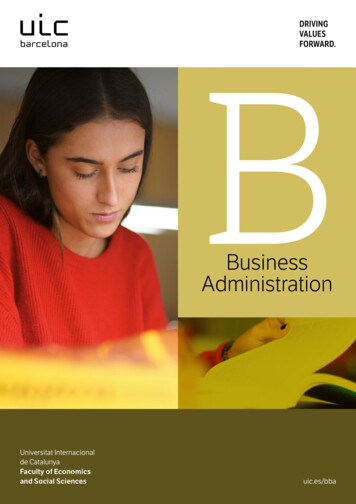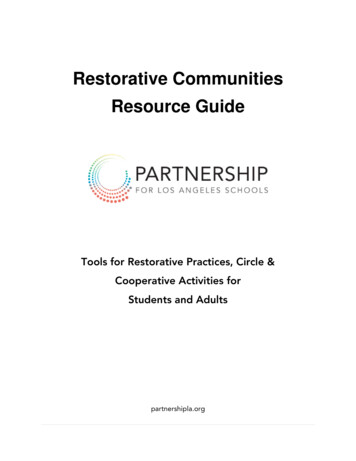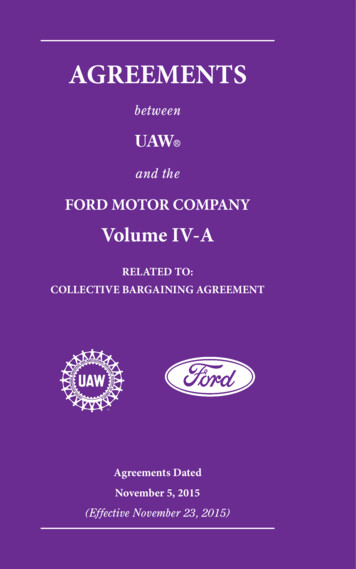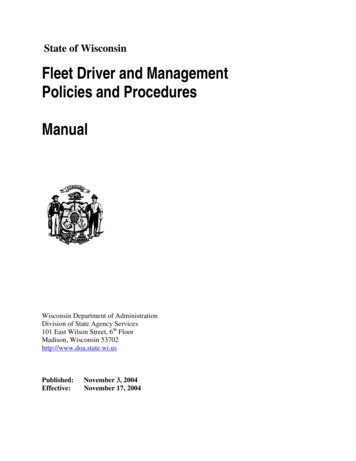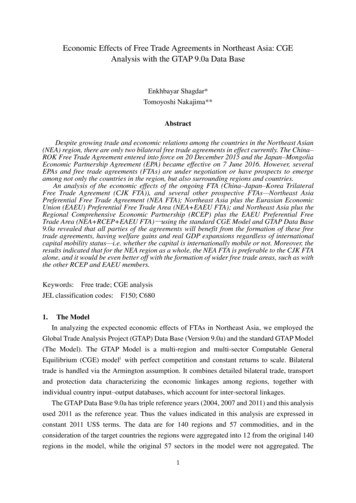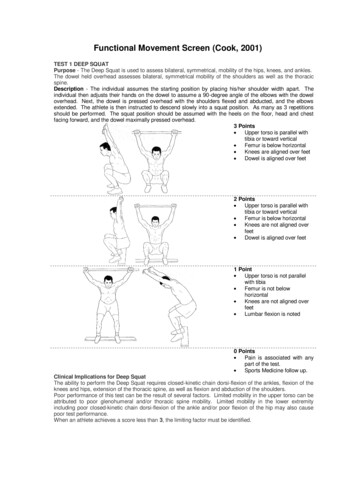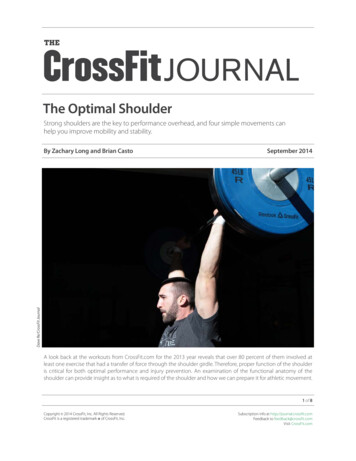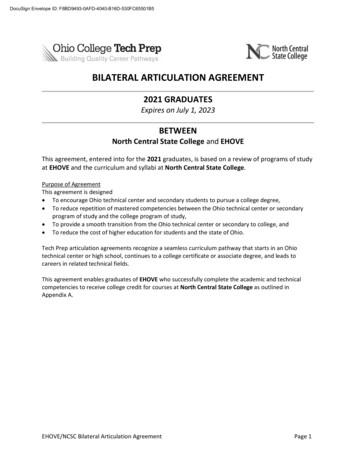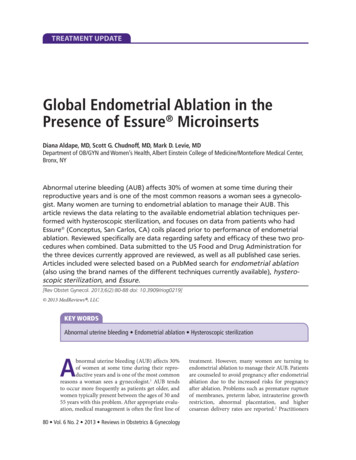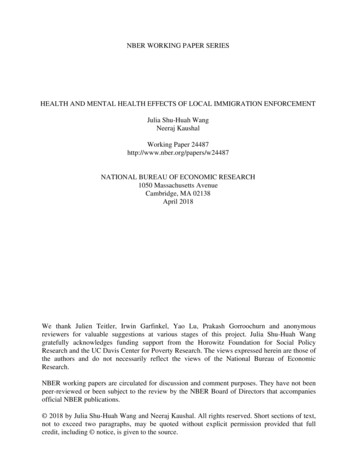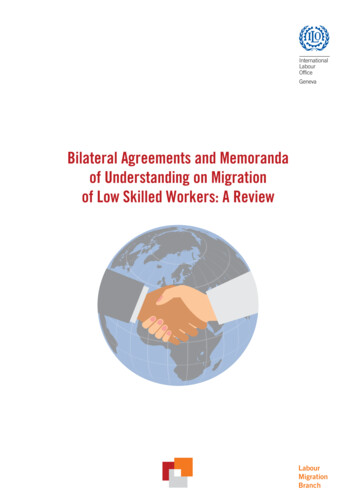
Transcription
Bilateral Agreements and Memorandaof Understanding on Migrationof Low Skilled Workers: A ReviewLabourMigrationBranch
Bilateral Agreements and Memorandaof Understanding on Migration of LowSkilled Workers: A ReviewINTERNATIONAL LABOUR OFFICE GENEVA
Copyright International Labour Organization 2015First published 2015Publications of the International Labour Office enjoy copyright under Protocol 2 of the Universal Copyright Convention.Nevertheless, short excerpts from them may be reproduced without authorization, on condition that the source isindicated. For rights of reproduction or translation, application should be made to ILO Publications (Rights andPermissions), International Labour Office, CH-1211 Geneva 22, Switzerland, or by email: pubdroit@ilo.org. TheInternational Labour Office welcomes such applications.Libraries, institutions and other users registered with reproduction rights organizations may make copies in accordancewith the licences issued to them for this purpose. Visit http://www.ifrro.org to find the reproduction rights organizationin your country.Wickramasekara, PiyasiriBilateral agreements and memoranda of understanding on migration of low skilled workers: a review / Report preparedfor the Labour Migration Branch / Piyasiri Wickramasekara; International Labour Office – Geneva: ILO, 2015, 64 p.ISBN: 978-92-2-130025-0 (print)ISBN: 978-92-2-130026-7 (web pdf)International Labour Officeinternational migration / labour migration / migrant worker / unskilled worker / international agreement14.09.2ILO Cataloguing in Publication DataThe designations employed in ILO publications, which are in conformity with United Nations practice, and thepresentation of material therein do not imply the expression of any opinion whatsoever on the part of the InternationalLabour Office concerning the legal status of any country, area or territory or of its authorities, or concerning thedelimitation of its frontiers.The responsibility for opinions expressed in signed articles, studies and other contributions rests solely with theirauthors, and publication does not constitute an endorsement by the International Labour Office of the opinionsexpressed in them.Reference to names of firms and commercial products and processes does not imply their endorsement by theInternational Labour Office, and any failure to mention a particular firm, commercial product or process is not a signof disapproval.ILO publications and electronic products can be obtained through major booksellers or ILO local offices in manycountries, or direct from ILO Publications, International Labour Office, CH-1211 Geneva 22, Switzerland. Cataloguesor lists of new publications are available free of charge from the above address, or by email: pubvente@ilo.orgVisit our website: http://www.ilo.org/publnsThis publication was produced by the Document and Publications Production,Printing and Distribution Branch (PRODOC) of the ILO.Graphic and typographic design, layout and composition, manuscript preparation,copy editing, proofreading, printing, electronic publishing and distribution.PRODOC endeavours to use paper sourced from forests managedin an environmentally sustainable and socially responsible manner.Code: DTP-CAD-REPRO
Bilateral Agreements and Memorandaof Understanding on Migration of LowSkilled Workers: A ReviewPiyasiri Wickramasekara*July 2015* This is a shorter version of a research report prepared for the Labour Migration Branch of the ILO. Mr. Jesse Mertens, ResearchOfficer, ILO Labour Migration Branch, has provided valuable research support for the preparation of this report. It has also drawnupon regional research undertaken by J. Simeone (Europe and the Americas), L.K. Ruhunage (Asia), and S. Monterisi (Africa)supported by the Global Knowledge Partnership on Migration and Development (KNOMAD) of the World Bank.
Contents1.Introduction . . . . . . . . . . . . . . . . . . . . . . . . . . . . . . . . . . . . . . . . . . . . . . . . . . . . . . . . . . . . . . . . . . . . . . . 72.Objectives of the study . . . . . . . . . . . . . . . . . . . . . . . . . . . . . . . . . . . . . . . . . . . . . . . . . . . . . . . . . . . . . . 93.Contribution of the study . . . . . . . . . . . . . . . . . . . . . . . . . . . . . . . . . . . . . . . . . . . . . . . . . . . . . . . . . . . . . 114.Methodology . . . . . . . . . . . . . . . . . . . . . . . . . . . . . . . . . . . . . . . . . . . . . . . . . . . . . . . . . . . . . . . . . . . . . . 134.1. Definitions and concepts . . . . . . . . . . . . . . . . . . . . . . . . . . . . . . . . . . . . . . . . . . . . . . . . . 134.2. Research methods . . . . . . . . . . . . . . . . . . . . . . . . . . . . . . . . . . . . . . . . . . . . . . . . . . . . . . 144.3. Limitations of the study . . . . . . . . . . . . . . . . . . . . . . . . . . . . . . . . . . . . . . . . . . . . . . . . . . 155.Historical overview and current developments . . . . . . . . . . . . . . . . . . . . . . . . . . . . . . . . . . . . . . . . . . 176.Findings of the BLAs mapping exercise . . . . . . . . . . . . . . . . . . . . . . . . . . . . . . . . . . . . . . . . . . . . . . . . 216.1. Type of agreements . . . . . . . . . . . . . . . . . . . . . . . . . . . . . . . . . . . . . . . . . . . . . . . . . . . . . 216.2. Parties to the agreements . . . . . . . . . . . . . . . . . . . . . . . . . . . . . . . . . . . . . . . . . . . . . . . . 226.3. Analysis of mapped agreements by date of signing . . . . . . . . . . . . . . . . . . . . . . . . . . . . . 226.4. Objective of agreements . . . . . . . . . . . . . . . . . . . . . . . . . . . . . . . . . . . . . . . . . . . . . . . . . . 236.5. Good Practices in mapped agreements . . . . . . . . . . . . . . . . . . . . . . . . . . . . . . . . . . . . . . 246.6. Adherence to the ILO 1949 Model Agreement provisions in mapped agreements . . . . . . 326.7. North-South differences . . . . . . . . . . . . . . . . . . . . . . . . . . . . . . . . . . . . . . . . . . . . . . . . . 336.8. Findings of the case studies . . . . . . . . . . . . . . . . . . . . . . . . . . . . . . . . . . . . . . . . . . . . . . 347.Towards a preliminary framework for assessing BLAs . . . . . . . . . . . . . . . . . . . . . . . . . . . . . . . . . . . . 377.1. How can bilateral agreements and MOUs improve governance of labour migration? . . . . 377.2. In what ways can bilateral agreements promote and protect the rightsof migrant workers? . . . . . . . . . . . . . . . . . . . . . . . . . . . . . . . . . . . . . . . . . . . . . . . . . . . . . 407.3. In what ways can bilateral agreements promote migration and development linkages? . . 428.Recommendations . . . . . . . . . . . . . . . . . . . . . . . . . . . . . . . . . . . . . . . . . . . . . . . . . . . . . . . . . . . . . . . . . 458.1. Recommendations to Governments of origin and destination countries . . . . . . . . . . . . . . 458.2. Recommendations to regional integration and consultative process . . . . . . . . . . . . . . . . . 478.3. Recommendations to social partners and other stakeholders . . . . . . . . . . . . . . . . . . . . . . 478.4. Recommendations to ILO and other international agencies . . . . . . . . . . . . . . . . . . . . . . . 488.5. Areas for further work . . . . . . . . . . . . . . . . . . . . . . . . . . . . . . . . . . . . . . . . . . . . . . . . . . . 48References . . . . . . . . . . . . . . . . . . . . . . . . . . . . . . . . . . . . . . . . . . . . . . . . . . . . . . . . . . . . . . . . . . . . . . . . . . . 49Annexes . . . . . . . . . . . . . . . . . . . . . . . . . . . . . . . . . . . . . . . . . . . . . . . . . . . . . . . . . . . . . . . . . . . . . . . . . . . . . . 55Annex 1: Methodological note on assessment of BAs and MOUs . . . . . . . . . . . . . . . . . . . . . . . 55Annex 2. Table A1: Good practices scores by region . . . . . . . . . . . . . . . . . . . . . . . . . . . . . . . . . 56Annex 3. Table A2 – 1949 ILO Model Agreement topics (n 27) . . . . . . . . . . . . . . . . . . . . . . . 58Annex 4: Table A3 – Summary of case studies . . . . . . . . . . . . . . . . . . . . . . . . . . . . . . . . . . . . . 60Annex 5: Recognition of BAs/MOUs in national law and policies – Asia . . . . . . . . . . . . . . . . . . 62Annex 6: Acronyms . . . . . . . . . . . . . . . . . . . . . . . . . . . . . . . . . . . . . . . . . . . . . . . . . . . . . . . . . . 635
1. IntroductionMigration is “a key feature of today’s world of work and one which raises complex policy challenges”(ILO, 2014a: 1). The increasing complexity of the nature and composition of today’s internationalmigration movements underscores the importance of international cooperation in the governanceof migration processes and the protection of migrant workers. Such cooperation on migration cantake various forms, ranging from multilateral and regional to national-level agreements. InternationalConventions and instruments relating to migrant workers represent multilateral initiatives. The HighLevel Dialogue on International Migration and Development (United Nations, 2013b), the GlobalMigration Group (GMG), the Global Forum for Migration and Development (GFMD) and the on-goingPost-2015 Development Agenda discussions all aim at promoting international cooperation in the areaof migration. At the regional level there are a number of economic integration initiatives in differentregions, and the European Union represents the most mature system of regional integration with freemovement of persons and labour mobility for all EU citizens. At the same time, bilateral cooperationhas become increasingly popular, as seen in bilateral labour arrangements (BLAs), such as bilateralagreements (BAs) and memoranda of understanding (MOUs)1 on labour migration found across allregions of the world.ILO instruments have long recognized the potential of bilateral agreements as a good practice inthe governance of labour migration flows between countries, and in contributing to the protectionof migrant workers. The ILO Migration for Employment Convention (Revised), 1949 (No. 97)recommends: “Whenever necessary or desirable, conclusion of agreements to regulate migration foremployment in cases where numbers of migrants are sufficiently large”. To give practical effect to this,the accompanying ILO Recommendation, 1949 (No. 86) contains a Model Agreement on Temporaryand Permanent Employment in its annex which has influenced the development of bilateral labourarrangements across the globe over the years, and whose principles still remain valid.2 The ILO TripartiteTechnical Meeting (TTM) of November 2013 called upon the ILO to “assist governments and socialpartners with policy guidance in developing, negotiating and effectively implementing bilateral or otherinternational agreements on labour migration, with a view to increasing positive outcomes for migrantworkers, countries of origin and destination, and sustainable enterprises” (ILO, 2013). The ILO DirectorGeneral’s report on Fair Migration for the 2014 International Labour Conference reiterated the role ofbilateral agreements for well-regulated and fair migration between member States (ILO, 2014a).Thus the ILO also needs a strong research and evidence base on BLAs to meet the technical cooperationdemands of its constituents in line with the above mandate. The current research has been undertakenas part of ILO’s efforts to fill this need, in cooperation with the Thematic Working Group 3 on LowSkilled Migration of the Global Knowledge Partnership on Migration and Development (KNOMAD) of theWorld Bank, which supported regional research covering BLAs.1 In the subsequent analysis, the paper occasionally uses the term ‘agreement’ to refer to all types – BAs, MOUs, FrameworkAgreements, etc.2 According to the ILO’s Permanent Migration Committee in its third session: “A Model Agreement is a new instrument and isnot covered by the Constitution but as the present proposed Model Agreement is to be annexed to the Recommendation, it willhave the same status as a Recommendation” (ILO, 1949: 80)7
2. Objectives of the studyi.To review trends in developments of BAs and MOUs focussing on low-skilled migration based on aglobal mapping exercise.ii.To identify good practices in BAs and MOUs based on specific criteria drawn from internationalnorms, and highlight agreements which could lead to better outcomes in terms of migrationgovernance and protection of migrant workers.iii. Formulate policy advice and recommendations based on the findings, and identify areas forfurther work.9
3. Contribution of the studyThe study expands on earlier literature in this field (OECD, 2004; Saez, 2013) by providing broaderglobal coverage, and reviewing more recent agreements.The analysis adopts a rights-based approach in assessing the quality of BAs and MOUs based oninternational norms. The set of good practice criteria employed is drawn from the four pillars ofinternational instruments for the protection and governance of labour migration (see Box 1), and the1949 ILO Model Agreement. It focusses on agreements dealing with low skilled migration, whereprotection problems are generally more acute. The current study covers agreements concluded inAsia, Africa, Europe, Arab States, and the Americas. It is also the first exercise to undertake a detailedmapping of bilateral agreements from different regions, based on a content analysis of 144 agreementtexts. The study also draws attention to the role of gender concerns and social dialogue in relationto these agreements, which have not been given adequate attention in previous studies. Finally,the study explores a preliminary framework for evaluation of BLAs based on good practice criteriaand contribution to better governance of labour migration, protection of migrant workers and thedevelopment impact – major themes drawn from the ILO Multilateral Framework on Labour Migration(ILO, 2006).The OECD and World Bank studies, though extensive and insightful, make scant reference to existinginternational instruments and labour standards, and no reference at all to the ILO’s model bilateralagreement. With a single exception, there is no reference made to gender issues in both volumes.There are a few reviews of bilateral labour agreements relating to the Asian region (Battistella andKhadria, 2011; Blank, 2009; Go, 2004, 2012; Vasuprasat , 2008; Wickramasekara, 2006, 2012).Ghosheh (2009) carried out a pioneering analysis of legal agreements applicable to internationalmigrant domestic workers. A comprehensive country level analysis of bilateral MOUs entered into bythe Government of India with destination countries in the Gulf Cooperation Council (GCC) states, Jordanand Malaysia was sponsored by the Migrant Forum in Asia (Wickramasekara, 2012). The study failedto find any concrete evidence that the agreements had contributed to improved governance of labourmigration between India and concerned destination countries or significantly improved the protectionof low-skilled Indian workers in those destinations.Box 1. Normative foundations of bilateral labour agreementsInternational Instruments at four levels provide a solid foundation for developing bilateral agreements andMOUs for good governance of labour migration and protection of migrant workers.a) Nine UN Universal human rights instruments and associated Protocolsb) Eight ILO Core Conventions on fundamental principles and rights at work pertaining to forcedlabour, freedom of association, child labour and discrimination.c) Three international Migrant worker specific Conventions: ILO Migration for Employment Convention, 1949 (No.97) ILO Migrant Workers Convention , 1975 (No.143) (UN) International Convention on the Protection of the Rights of All Migrant Workers andMembers of Their Families, 1990 (ICMW).d) All other labour standards that apply to migrant workers including particularly the ILO Conventionson Private Employment Agencies, 1997 (No.181) and the Domestic Workers Convention, 2011(No. 189).Finally, the ‘ILO Multilateral Framework on Labour Migration: Non-binding principles and guidelinesfor a rights-based approach to labour migration’ is a compendium of principles & guidelines on labourmigration based on the above instruments, and negotiated through tripartite consultations (ILO, 2006).11
4. Methodology4.1. Definitions and conceptsÔÔ Bilateral agreement: it is a treaty as described under the 1969 Vienna Convention on the Law ofTreaties: “an international agreement concluded between States in written form and governed byinternational law, whether embodied in a single instrument or in two or more related instrumentsand whatever its particular designation” (cited in United Nations, 2012: 81). BAs are agreementsbetween two States which describe in detail the specific responsibilities of, and actions to betaken by each of the parties, with a view to accomplishing their goals. BAs create legally bindingrights and obligations.ÔÔ Memorandum of Understanding (MOU): “A memorandum of understanding is an internationalinstrument of a less formal kind. It often sets out operational arrangements under a frameworkinternational agreement. It is also used for the regulation of technical or detailed matters. Itis typically in the form of a single instrument and does not require ratification”3. MOUs entailgeneral principles of cooperation describing broad concepts of mutual understanding, goals andplans shared by the parties. They are usually non-binding instruments.BAs therefore tend to be more specific and action-oriented than MOUs. An MOU is a softer, oftennon-binding option, generally providing a broad framework through which to address common concerns(United Nations, 2012). Several forms of bilateral arrangements and cooperation on migration can beidentified, and it is important to highlight their diversity of relating to mobility of labour (see Box 2).As the present study focusses mainly on BAs and MOUs for labour migration of low-skilled workers, itexcludes a number of these modalities.Box 2. Diversity of agreements/mechanisms of cooperationÌÌ Bilateral agreements (BAs)ÌÌ Memorandum of understanding (MOUs)ÌÌ Framework agreements: broad bilateral cooperation instruments covering a wide range of migrationrelated matters, including labour migration but also irregular migration, readmission, and the nexusbetween migration and development.ÌÌ Inter-Agency Understanding (IAU): such as the New Zealand – Pacific Islands States agreements,which are similar to MOUs.ÌÌ Protocols (Additional or Optional): instruments entered into by the same parties of, and which amend,supplement or clarify a previous agreement.ÌÌ Agreements for hiring seasonal workers (Canada-Mexico; Germany-Poland)ÌÌ Cross-border worker agreementsÌÌ Statements of mutual labour cooperation or informal assurancesÌÌ Bilateral social security agreementsÌÌ Anti- trafficking agreementsÌÌ Trainee schemes: Japan, Republic of Korea (replaced by the Employment Permit System)ÌÌ Working holiday maker schemesÌÌ Multilateral agreements: Mode 4 of General Agreement on Trade in Services: Movement of naturalpersonsSources: (ILO, 2010; OECD, 2004; Wickramasekara, 2006)3 United Nations Treaty Collection web portal: Section on definitions (accessed 10 July, 2014). https://treaties.un.org/pages/Overview.aspx?path overview/definition/page1 en.xml#memoranda13
Bilateral Agreements and Memoranda of Understanding on Migration of Low Skilled Workers: A ReviewIn general, bilateral labour arrangments are less common compared to international investmentagreements and bilateral investment treaties (BITS), which have become the most important internationallegal mechanism for the governance of foreign direct investment (FDI) over the past four decades.The United Nations Conference on Trade and Development (UNCTAD) reported 3,240 InternationalInvestment Agreements globally at the end of 2013 (UNCTAD, 2014). The OECD identified 176 labouragreements involving at least one OECD member in 2004 (OECD, 2004) while the present studyidentified about 358 labour agreements.4.2. Research methodsThe present research adopted several strategies in its assessment of BAs and MOUs on labour migration.a) Literature ReviewAn ILO consultant carried out a preliminary literature survey before the launching of the research project(Khan, 2014). This was followed by a more comprehensive literature search of theory and practiceof bilateral agreements by the research coordinator. In addition, the research coordinator has drawnupon his extensive practical experience on labour migration issues in general, and bilateral agreementsand MOUs in particular. To supplement the literature survey, the coordinator also conducted informalinterviews with officials from Bangladesh, Indonesia, Jordan, Nepal, Philippines and Sri Lanka, and theMigrant Forum in Asia on relevant issues.b) Regional research and mappingThree mapping studies were carried out to obtain information from different regions covering144 agreements (Table 1): Africa, Asia, and Europe and the Americas. Most Asian represented Southto South agreements, while Africa and the Europe & Americas (EA) contained both South to North andSouth to South agreements.Table 1. Agreements mapped and case studiesKnownagreements(estimate)*Full nterisi (2014)Asia96655Ruhunage (2014)Europe and the Americas221477Simeone (2014)Total35814415* Figures likely underestimate existing bilateral labour arrangements.c) Assessment of mapped agreements in relation to international norms and good practicesThe research programme adopted two separate (though inter-related) evaluative tools for the comparativeassessment of BAs and MOUs in terms of scope (breadth) and quality (depth) of agreements. The firstset of criteria (comprehensiveness and scope) assessed the extent of coverage of the provisions ofthe 1949 ILO Model Agreement on Temporary and Permanent Migration for Employment, including14
MethodologyMigration of Refugees and Displaced Persons.4 The second set of criteria (quality) assessed agreementson the basis of 18 good practice criteria (GP) on good governance of labour migration and protection ofmigrant workers drawn from international norms and consultation with ILO experts. Annex 1 providesmore details on the methodology, and Table A1 (Annex 2) and Table A2 (Annex 3) list the good practicecriteria and the model agreement provisions by region respectively.The coding of good practice criteria by regional researchers was harmonized through feedback providedby the lead researcher at different stages, and quality checks of coding of selected agreementsundertaken in cases of ambiguity.d) Case studies of BAs/MOUs known to be promising or with above average scoresThe study carried out 15 case studies to highlight good elements and practices on specific BLAsselected on the basis of the mapping exercise (Annex 4: Table A3). The main criteria used for selectionare as follows:ÔÔ Type of Agreement: BAs, MOUs and Framework Agreements.ÔÔ Availability of evidence of implementation or follow-upÔÔ Relatively good scores in terms of good practices and model agreement provisionsÔÔ Desirable features such as accompanying Model Employment ContractsÔÔ Need to represent different types of work: domestic workers, seasonal, sectoral and generalworkers.The case studies went beyond content analysis to consult secondary sources and evaluations andcollect additional information on their working, such as through stakeholder interviews. The availableinformation varied across the agreements studied.4.3. Limitations of the studyWhile the research attempted to provide a comprehensive mapping of all known BLAs, it couldaccess full texts for only 144 agreements. In several countries, copies of agreements signed wereneither accessible on the public domain nor made available on request (e.g. China, Malaysia, Pakistanand Vietnam).5The study is based primarily on a content analysis of BA/MOU texts. The approach has inherentlimitations because it cannot adequately assess the effectiveness of agreements in terms of actualimplementation. A good practice on paper does not automatically translate into good implementation.There was also a notable lack of information on follow up and implementation in the countriesconcerned. Even in the case of the Philippines, which is more transparent about its agreements thanmost other countries, “the exchange of notes, minutes of consultations and meetings, drafts andimplementing guidelines, which are essential to review and revise the agreements, cannot be found(CMA, 2010: 30).”6 Therefore, the findings of the regional case studies should be regarded as tentative,which need to be followed up by in-depth field research on implementation processes.4 Out of the 29 Articles of the ILO model agreement, two (14 and 18) relate specifically to permanent migration. Thus only27 Articles were considered here as relevant to temporary labour migration. Some sections of other articles also may apply onlyto permanent migrants or refugees. The ILO model agreement contains 29 provisions or elements – not ‘24 essential elements’as wrongly claimed in recent literature (e.g. ILO, 1997; Geronimi, 2004; OSCE, IOM, & ILO, 2007; Saez, 2013; Khan, 2014).See Wickramasekara (2014c) for details.5 The researchers sought assistance of the ILO Offices in the relevant countries for access to agreements.6 The author’s discussions with embassy officials of the Philippines in Jordan in February 2014 confirmed that this additionalmaterial is generally not made available to third parties.15
5. Historical overview and currentdevelopmentsThe use of BLAs dates back to the early 1900s. Böhning (2012) cites the 1904 bilateral agreementbetween France and Italy as the first one of its kind. The ILO’s 1921 International Emigration Commissionreport highlighted a number of principles to be followed ‘when bilateral conventions for the recruitmentof bodies of workers are made between Members or where collective recruiting takes place inanother country’, including supervision by competent authorities, recruitment by authorised agencies,consultation of employers and workers’ organization and issuance of fully enforceable contracts, amongothers (ILO, 1921). Rass (2012: 192) noted: “Between World War I and the oil-price shock of the mid1970s, bilateral agreements between countries became the institutional backbone of labour migrationin Europe as people moved from its peripheries to its economic centres”.The period from the 1940s to about 1970 is described as the golden age of bilateral labour agreements(ILO, 2010). The labour demand for the reconstruction of post war Europe also gave rise to majormigration movements into European countries based on bilateral agreements in the 1950s and 1960s.Belgium, France, the then Federal Republic of Germany (West Germany), and the Netherlands allconcluded agreements with one or more origin countries – Ireland, Southern Europe (Greece, Italy,Portugal, Spain), Turkey, the former Yugoslav Republic and North Africa (Algeria, Morocco, Tunisia)(ILO, 1999). The 1959 ILO global report on international migration covering the period 1945-1957described ‘agreements having the joint organization of migratory movements as their primary purpose’as ‘a new development in international law’ (ILO, 1959: 285). It noted that migration provisions werepreviously found in only friendship, trade or navigation treaties, and a number of establishment andlabour treaties concluded between European countries.An important feature of early agreements was the key role played by States in organizing and closelysupervising recruitment, employment, and return. High demand and competition for migrant workersled to improved agreements and eventually better working conditions for migrant workers. For instance,the 1964 German bilateral labour agreement with Turkey was a much improved version of the 1961agreement in terms of labour rights (Rass, 2012). West Germany and some other governments closelyadhered to provisions of the 1949 ILO Convention and Recommendation on migrant workers, settingup public recruitment offices under the auspices of bilateral agreements, and medically examiningcandidates, among other things (Böhning, 2012: 14). According to Rass (2012), labour migrationbetween 1960 and 1973 involved the movement of more than 30 million people into the core economiesof north-western Europe from southern and south-eastern Europe and
Box 1. Normative foundations of bilateral labour agreements International Instruments at four levels provide a solid foundation for developing bilateral agreements and MOUs for good governance of labour migration and protection of migrant workers. a) Nine UN Universal human rights instruments and associated Protocols
